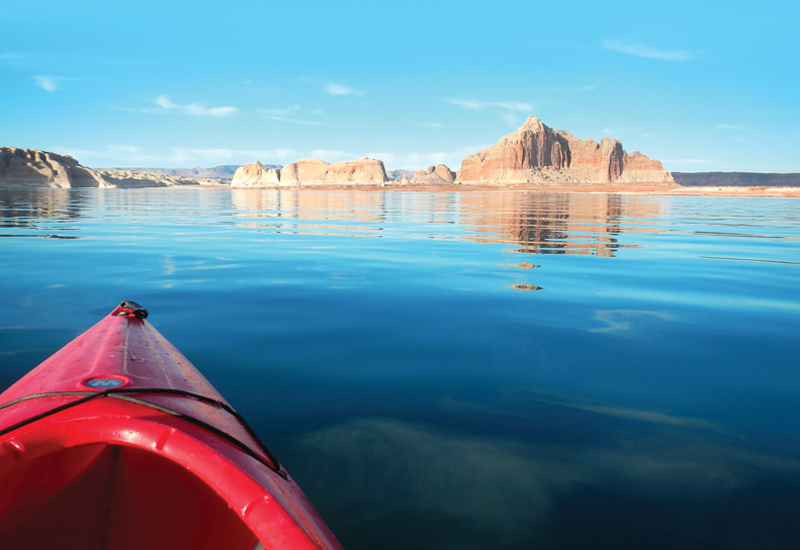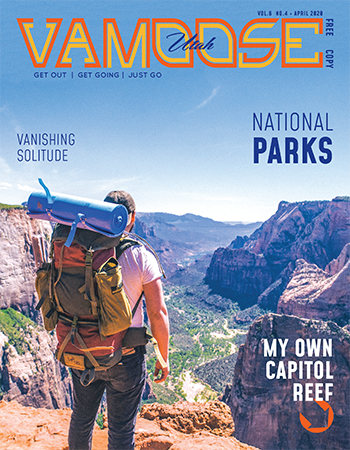Utah’s water policy and usage does not match its supply
Opinion by Megan Walsh
The wind is brisk and the air cool as I step out of my Prius at the Lake Powell lookout off U.S. Route 89. With me is my pup, Nala, whose only desire is to explore all the scents, critters, nooks and crannies of this new place. Watching her race around, exploring far and wide, with such ferocity makes me think about the men and women who explored these canyon walls and desert expanses with the same fervor as Nala.
I think about John Wesley Powell, in particular, and how his crew navigated unexplored rivers, portaged dories in newly named outlets and documented every detail in a painstaking style that now seems a lost art. As Powell discovered and named the Red and Labyrinth canyons, Music Temple and Dirty Devil, he ruminated on the future of civilization in the American West. Even then, he knew that the arid landscape, while vast, hadn’t enough water to sustain large populations. “Many droughts will occur; many seasons in a long series will be fruitless,” Powell warned in his 1878 Report on the Lands of the Arid Region of the United States.
Yet, his warning went mostly unheeded. Utahns apparently believe that we are smiled upon from above. The biblical prophet Isaiah said in 35:1 that for those who put faith and trust in God, “the desert shall rejoice, and blossom as the rose.” Religiosity aside, it takes a lot of water to make a desert bloom.
Fast-forward to the Colorado River Compact of 1922, which established how seven states in America’s Southwest would share the Colorado’s precious bounty. Then speed ahead to the 15 dams constructed on the main stem of the Colorado River from 1905 to 2007, including six in Utah if we include the Glen Canyon Dam that’s technically in Arizona. And here we are today, downplaying the scarcity of water in Utah. We water our lawns and propose pipelines as if we haven’t experienced below-average snowfall in the last 12 of 20 winters, as if the driest winter on record didn’t happen only four years ago.
Due to the unpredictable nature of recent winters in the West and along with a nudge from Congress, seven Western states recently signed the Colorado River Drought Contingency Plan to create state-by-state protocols should reservoirs along the Colorado River continue to shrink below their current historic lows.
Utah, Arizona, New Mexico, Nevada, Wyoming, Colorado and California—all signatories of the contingency plan—draw irrigation, household and drinking water from the Colorado River and carry it to more than 35 million people across the upper and lower basins. Each year, the river swells with melted alpine snow from the Rockies, stalls at hundreds of dams along its tributaries and then flows through pipelines and aqueducts to these seven adjacent states and into Mexico.
Utah’s interest is most vested where the Colorado River travels along the Utah/Arizona border and meets the Glen Canyon Dam to form Lake Powell. If there’s a physical display of drought in Utah, it is most evident in the white bathtub rings above Lake Powell, indicating the lake’s highest level to where it is today, down some 120 feet.
Each year, aside from usage in the upper and lower basins, Lake Powell loses roughly 380,000 acre-feet of water to seepage and another 560,000 acre-feet to evaporation from relentless desert heat, according to a 2013 study from the Journal of the American Water Resources Association. For context, the amount lost to Lake Powell’s sandstone banks is equivalent to Nevada’s entire water allocation in the Colorado River Compact.
Yet, despite record-low levels in Powell and its slow creep toward “dead pool” status, the Utah Division of Water Resources continues to push for the $1.8 million Lake Powell Pipeline to siphon 86,000 acre-feet of water each year and propel it 140 miles through five pumping stations to St. George.
If siphoning off 28 billion gallons of water out of an already shrunken reservoir doesn’t seem ill-advised, consider efforts made in 2015 and 2017 to conserve only 22,000 acre-feet of water by compensating farmers (to the tune of $4.5 million) to forgo the use of irrigation water, which is only a third of the proposed pull by the pipeline.
Why should Utah taxpayers pay for this? We’re told it’s because demand for water in the burgeoning St. George population is exceeding its supply. But some contend it’s because Utah is not using its entire legal share of the Colorado River, and we’re creating a use for it before we lose it.

Beautiful Lake Powell
Meanwhile, in the Wasatch
Those in Salt Lake City are fortunate—90% of the Wasatch Front water supply travels from the peaks of the Wasatch into our faucets and sprinklers, and the remaining 10% comes from nearby aquifers. This water isn’t shared with anyone but next-door neighbors. However, that doesn’t insulate us from future water issues.
“The primary threats to drinking water [along the Wasatch Front] are pollution and drought/climate change,” Laura Briefer, director of Salt Lake City’s Department of Public Utilities, says in an interview.
Deer Creek Reservoir acts as a back-up for Wasatch water use, holding run-off through Decker Creek and the Provo River, but if the Salt Lake Valley population doubles in the next 50 years as Kem C. Gardner Policy Institute projects, and our winters become 18 degrees warmer in 60 years as predicted by a University of Maryland study, we’ll likely find ourselves grappling with drought on a scale the valley hasn’t seen before.
And yet, according to a recent Utah Geological Survey, Utah’s public water supply customers use 248 gallons of water on a daily basis, the highest consumption of any other state in the country.
Our excessive use of water in the desert is both fascinating and alarming.
While the Colorado River and Lake Powell are indicators of our capacity to deplete natural resources, they also show our ability to work together to preserve them. Pipeline proposals and exorbitant water usage make the future of Utah waterways look grim, but we’ve proven our ability time and again to prevent the worst from happening.
As I look out over Lake Powell at the sharp contrast between the original waterline and the current one at the mighty Glen Canyon Dam and at the Wahweap Marina inching closer to the shoreline, I can’t help but feel a twinge of concern and maybe even remorse for how we use our water. While there may not be hope for the past, there will always be hope for the future. There has to be.



